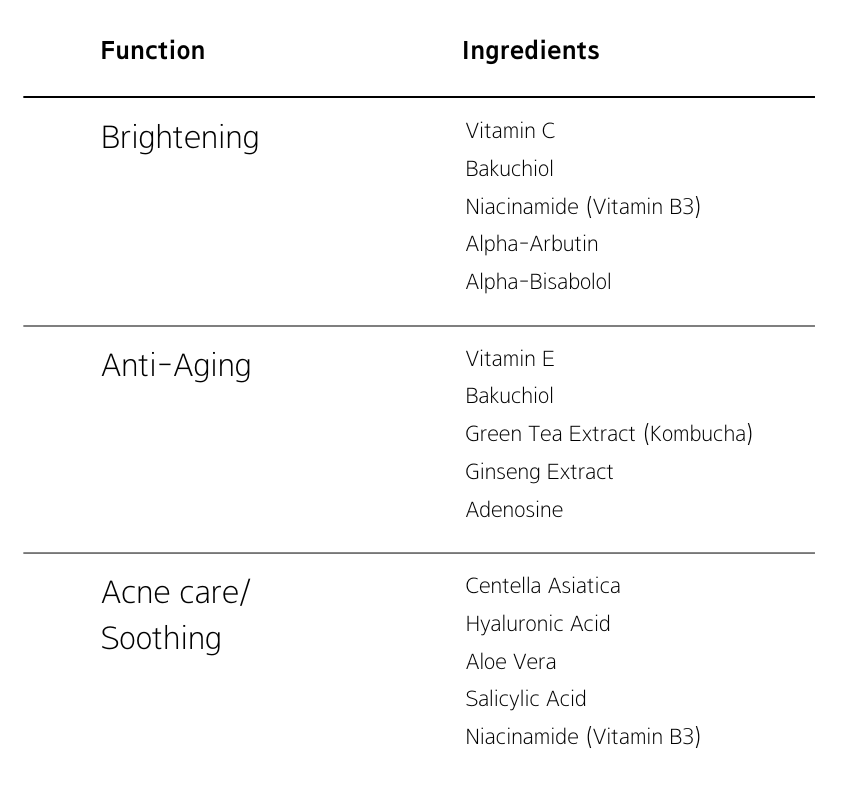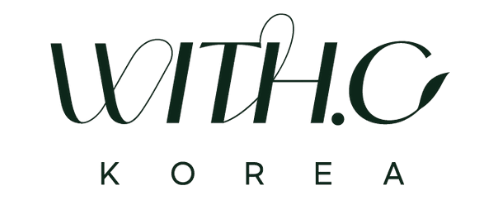Trendy ingredients in Korean cosmetics
“Contains OO extract, which is effective in soothing the skin and supplying nutrients, thereby increasing moisture and radiance within the skin.”
“86% reduction in redness, 102% improvement in damaged skin barrier, 79% reduction in dead skin mass after just one use”
These are the Koreans’ famous functional cosmetics’ advertising slogans.
The second phrase may seem enticing at first glance, but upon closer examination, it’s revealed to be potentially deceptive with the disclaimer of ‘temporary’ buried in the fine print.
Today, let’s shift our focus from relying on advertising slogans to sharing factual information we know!
With this purpose in mind, let’s delve into the facts about functional cosmetics and their corresponding ingredients for each function among korean cosmetics.
Functional cosmetics’ Definition:
Refer to skincare products that offer additional benefits beyond basic moisturizing, such as improving skin health and addressing specific concerns like aging or acne. They are formulated with active ingredients designed to deliver therapeutic effects to the skin.
In recent years, there has been a rise in skincare products offering double or triple functions, rather than focusing on just one effect.
While single-function products may provide quick results, overuse can lead to skin irritation and damage.
On the other hand, double and triple functional products require consistent use but are less likely to cause skin irritation, offering a relatively worry-free skincare experience.
And understanding the main ingredients for each function is crucial for making informed skincare choices.
Main ingredients for functional Cosmetics:

1. Brightening
- Vitamin C (Ascorbic Acid): Potent antioxidant inhibits melanin, brightens skin, boosts collagen.
- Bakuchiol: Retinol-like effects stimulate collagen, improve elasticity, reduce wrinkles.
- Niacinamide (Vitamin B3): Reduces melanin transfer, fades dark spots, strengthens skin, anti-inflammatory.
- Alpha Arbutin: Natural skin-lightening inhibits melanin, fades dark spots.
- Alpha-Bisabolol: Soothing, reduces hyperpigmentation and redness, beneficial for uneven skin tone.
Among the listed whitening ingredients, the most commonly used and widely recognized is probably Vitamin C (Ascorbic Acid).
And these days, bakuchiol is increasingly being used as a replacement for retinol.
It’s a popular choice due to its effectiveness in brightening the skin, lightening dark spots, and evening out skin tone.
Additionally, vitamin C and Bakuchiol offer antioxidant benefits and promotes collagen production, making it a versatile ingredient in skincare formulations.
2. Anti-Aging
- Vitamin E: Powerful antioxidant prevents premature aging, strengthens skin barrier, promotes healing for youthful complexion.
- Bakuchiol: Natural retinol alternative boosts collagen, reduces wrinkles, promotes smoother skin without irritation.
- Green Tea Extract: Rich in antioxidants, protects against aging, reduces inflammation, boosts collagen for firmer skin.
- Ginseng Extract: Contains ginsenosides to improve circulation, reduce inflammation, and promote collagen for younger-looking skin.
- Adenosine: Anti-inflammatory, smooths skin, reduces wrinkles, enhances elasticity by stimulating collagen.
Especially these days, an increasing number of manufacturers are using kombucha instead of green tea extract.
Kombucha, which became famous thanks to BTS, is made by fermenting green tea or black tea.
It is rich in probiotics and organic acids compared to green tea, and is said to be particularly good for antioxidants.
3. Acne-care / Soothing
- Centella Asiatica (Gotu Kola): Anti-inflammatory, promotes wound healing, strengthens skin bar
- Hyaluronic Acid: Hydrates without clogging pores, soothes irritated skin.
- Aloe Vera: Soothes and reduces redness, hydrates, promotes healing.
- Salicylic Acid: Exfoliates, unclogs pores, regulates oil production, and reduces inflammation.
- Tea Tree Oil: Antibacterial and anti-inflammatory, combats acne-causing bacteria, soothes redness and swelling.
- Niacinamide (Vitamin B3): Regulates oil production, reduces inflammation, strengthens skin barrier, fades hyperpigmentation.
Hyaluronic Acid and Salicylic Acid are ingredients that continues to be popular. This ingredient is effective in treating acne by focusing on exfoliating the skin and unclogging pores.
Additionally, Centella Asiatica extract is widely used as the main base for acne-improving cosmetics.

Among the many skincare ingredients available, some are known to work particularly well when used together. This insight is derived from a post by ‘Hwahae’, Korea’s leading cosmetics analysis company.
Positive/Negative Ingredient Combinations:
Positive Ingredient Combinations:
- Salicylic Acid + Niacinamide: While salicylic acid is effective for acne, it can be irritating to the skin. Using it alongside niacinamide, which has soothing properties, can help mitigate any potential irritation.
- Vitamin C + Vitamin E: This combination is highly beneficial as vitamin E aids in the absorption of vitamin C, enhancing its effectiveness and prolonging its benefits.
Negative Ingredient Combinations:
- Vitamin C + Retinol, AHA, BHA: For sensitive skin or products susceptible to light and heat, such as retinol or exfoliating ingredients, combining them with vitamin C may lead to irritation.
- Acne Products + Anti-Aging Products: While acne products aim to reduce sebum production, anti-aging products often contain oils. Consequently, these two types of products may not be compatible.
Understanding the compatibility of skincare ingredients can help optimize the effectiveness of your skincare routine.
Knowing this information in advance allows for more effective selection and use of cosmetics. As you apply products to your precious skin, I hope you carefully analyze and use them rather than relying solely on advertising slogans.
